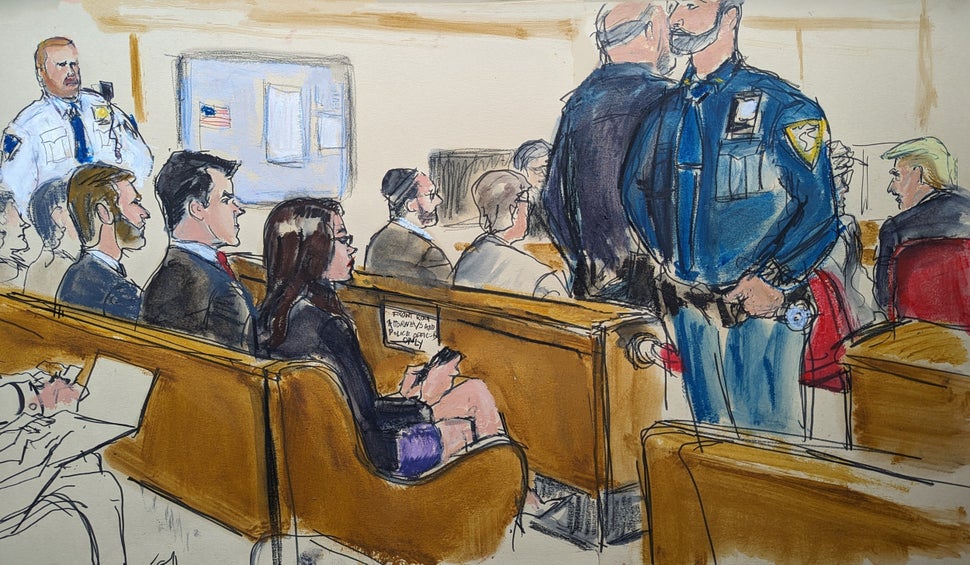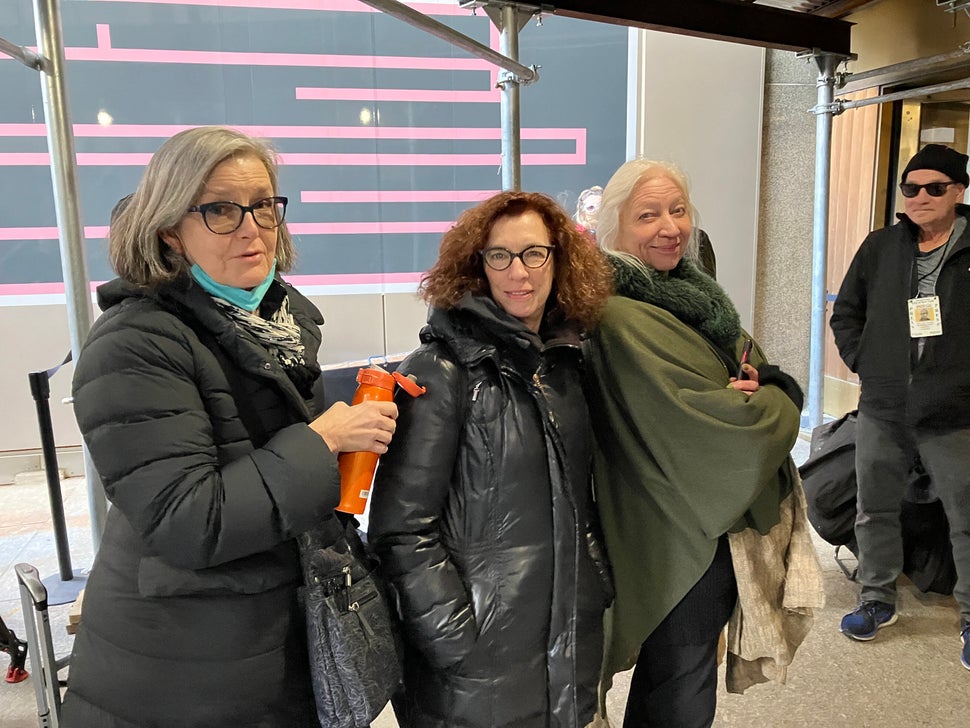Courtroom artists reveal the details of this extremely rare profession — and what makes Trump’s trial so tough.
For Elizabeth Williams, one of the three courtroom artists inside the Manhattan courtroom for former President Donald Trump’s trial, every day is a new challenge.
Take last Tuesday, when defense attorney Todd Blanche cross-examined Trump’s fixer-turned-enemy Michael Cohen on the witness stand. She nailed the former president’s facial expression. “He tends to purse his lips forward when he gets really pissed off. And he was doing that,” Williams told HuffPost on Sunday.
But on that particular drawing, she was less satisfied with how Cohen turned out, even though she felt she got his energy down. “Did I get a really great likeness of him? No, but that’s what the back-and-forth [between Blanche and Cohen] looked like.”
That’s the daily challenge of a courtroom artist. “It’s not like you can say, ‘I’ve been doing this for so long. It’s just so easy now.’ That’s just unfortunately not true,” Williams said, noting that she goes through “a lot of paper.”
Trump is on trial in New York for allegedly covering up hush money payments Cohen made on his behalf to Stephanie Clifford, an adult film star who goes by Stormy Daniels, ahead of the 2016 presidential election. And unless you’re a juror or journalist, you’re most likely only seeing the trial through Williams’ and other courtroom artists’ sketches.
New York remains one of the only jurisdictions that bans cameras in most courtrooms. In this high-profile criminal trial, as with many others where photography, broadcasting and livestreaming is limited or banned, courtroom art is one of the only ways that the public can see how the proceedings unfold.
These artists become responsible for conveying what it’s like to be in that room. It’s their job to capture the colors, moods and participants’ gestures, however fleeting.
What sets courtroom art from other mediums is how it can distill a scene into “the key most important elements and put them into an image. And it’s representative of the day’s story,” said Christine Cornell, one of the other courtroom artists covering the Trump trial.
Cornell noticed that her first drawings of Daniels made her simply look pretty, but she was later struck by a moment during Daniels’ testimony when she was making a face with her jaw.
“You want to just get it enough to show the agitation and that she’s expressing herself,” Cornell told HuffPost about why she chose that moment to zoom in on.
In one of her own drawings of Daniels, Williams highlighted how closely the jury listened to her testimony. She could not get the jurors’ faces, but she made sure to draw their hands jotting down notes.
“They were very attentive to her,” Williams said about the moment. “She’s talking to them. … Some witnesses don’t really address the jury. She did.”
What it’s really like to cover a historic trial
Each day, the three veteran courtroom artists –– Williams, Cornell and Jane Rosenberg –– are seated in the third row on the right side of the courtroom. They rotate spots daily. Williams was scheduled to sit on Tuesday on the far right next to the wall, which she said would give her a chance to see the jury and what they’re doing, for example.
Between them, the three artists have covered many famous cases, such as Tom Brady’s “Deflategate” saga, Harvey Weinstein’s 2020 rape trial and the trial of disgraced financier Jeffrey Epstein’s associate, Ghislaine Maxwell.
However, all three said this trial stands out for the intense security presence around the proceedings, including from police and the Secret Service. “They won’t even excuse us to leave until all the prosecutors are gone and Trump’s been gone for 20 minutes,” Cornell said.
Court artists are used to being able to draw people in seconds, she said. But it’s been hard to even catch a good glimpse of the star of the case, Trump, who is often blocked from view by court officers.
“Every day, I have to wait till [the officers] move or squeeze a peek in between them,” Rosenberg told HuffPost. “But [Trump]’s really fun to draw. He’s got great expression on his face, that pouty look. He’s got great bushy eyebrows and his helmet hair.”

Williams, who works with the Associated Press, said she has to adhere to strict AP editorial guidelines. “I can’t take a picture of Donald Trump and ram him up next to the witness box,” she explained. Some of her work does not include Trump, simply because she cannot see him.
As the weeks-long trial nears its conclusion, the artists have been pulling long hours to complete four to five sketches a day, which they shoot off to wire services or news outlets on breaks. Cornell said she’ll email her drawings in the bathroom.
“There’s a nice big window there with a counter. I set my drawings down, take a photograph and email it in. Very glamorous,” Cornell said.
The long days can be “physically draining,” Rosenberg said. To get the best view, Rosenberg, who is right-handed, has to work with her left hand at times, which hurts her back. To help, she wakes up at 4 a.m. and does back exercises and meditates.
“I’m exhausted right now, because I get up so early and I have such a long day, of course, but I don’t start drawing until like 9:30 [a.m.], when [Trump] walks in the room,” Rosenberg said.
Cornell said for her job, she uses a “couple hundred” pastels, binoculars and a seat cushion to help her see over people. She estimates that her portfolio and art supplies weigh more than 20 pounds.
And on the world stage, you have to be ready to face everybody’s opinion about your work. Critics often accuse courtroom artists of unfairly editorializing about the people they draw. At this year’s White House Correspondent’s Dinner, comedian Colin Jost said the artists were trying to make Trump look “like the Grinch” and “as bad as possible.”
Rosenberg said that this critique is “ridiculous.”
She said she’s has gotten more praise than criticism for her sketches during the trial — her arraignment sketch of Trump became a New Yorker magazine cover — but she does occasionally read negative feedback. Recently, she got an email from a person that said she inaccurately portrayed Cohen “as an old, sad, sick man” and Trump as “a strong middle-aged man.” She replied, saying that she was sorry that her work had let the the person down.
“It does make me feel bad,” she said of the criticism. “But I have to keep going.”
A rewarding but dwindling profession
Being a courtroom artist requires quick thinking and the ability to start over instantly if there’s a better scene to capture. It’s an “adrenaline rush,” Rosenberg said, noting that she sees her job as a “service for the public.“
But it’s a shrinking profession. Williams, who started doing courtroom art in 1980 after working as a fashion illustrator estimates there are only about 10 courtroom artists working across the nation right now. She said courtroom art is not her full-time job and she draws weddings and events on the side.

Cornell and Rosenberg both said they would not recommend the profession to others, because it can be hard to find steadily paying gigs. Even though she is well established, Cornell said she can go weeks without work.
“I don’t think it’s a good way to earn a living,” Rosenberg said.
But if you want to learn how to draw like one, grab a sketchbook, head to your local criminal courthouse and go to arraignment or a hearing. They are often open to the public and are the “bread-and-butter” assignments for courtroom artists, Williams said.
“A lot of artists feel like, ‘Oh, I can draw from photographs, so I can do all this.’ … Going from a photograph and drawing from life are totally different,” she said, noting how she has to deal with subjects who are constantly moving.
“Draw a lot and draw quickly and look at the scene — the scene is the drawing,” Williams advised aspiring courtroom artists. “Do it a lot and then you’ll finally start to get … something that you feel like, ‘Yeah, this is pretty good.’”
It can be hard work, but for courtroom artists, the enduring appeal of their job is getting to draw people. “I don’t really want to draw trees and flowers,” Williams said. “A seascape is only interesting if it has people in it.”
“People are so interesting. Just never boring,” Williams said. “A face has a multitude of muscles. That’s one of the things about Cohen, is that he has all these expressions, and just to grab one is really important. The eyebrows do all sorts of things.”
Soon the demanding days of the Trump trial will come to a conclusion. Both Cornell and Rosenberg said they are looking forward to the end.
On a recent day off, “I got up at 7:30 a.m. So late for me, I was so happy,” Rosenberg said. “It’s a luxury.”
“My dog misses me,” Cornell said. “It’s going to be fabulous when it’s over, and I’m just really interested to see what happens.”
Credit: Source link